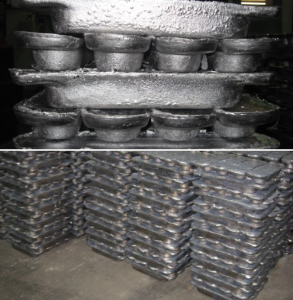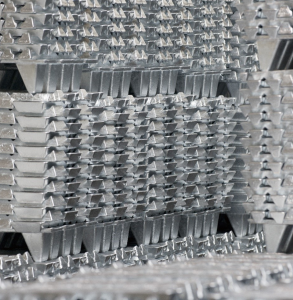Our Products
Base MetalsWe have an extensive range of base metals
Base metals refers to a group of widely-used metals in industry and commerce, known for their low cost and abundance. The term “base” distinguishes these metals from precious metals, which are typically used for jewelry, coins, or investment purposes. Common examples of base metals include copper, aluminum, nickel, zinc, and lead. These metals have a wide range of industrial applications due to their properties such as malleability, ductility, electrical conductivity, and thermal conductivity. Base metals are also used as alloys with other metals to improve their mechanical or chemical properties, making them essential in fields such as construction, manufacturing, and transportation.
Non-ferrous Metals
This include metals such as aluminum, copper, brass, zinc, and tin. These metals are typically more resistant to corrosion and are often used in electrical applications, as well as for building structures that need to be lightweight and/or resistant to corrosion.

Aluminum
(Primary/Secondary)
Aluminum produced directly from mined ore (bauxite) is classified as primary aluminum, which is highly energy intensive. Primary aluminum is made in slabs, billets, and ingots and can be rolled or extruded. A large part of primary aluminum is alloyed and used in aerospace, automotive, construction, packing, and electronics.
Aluminum scrap is recycled and made into a usable state. In the market, this is secondary aluminum alloy. Recycling is significantly less energy intensive. Secondary aluminum alloy is used in the same applications that produce aluminum scrap.
A critical application for secondary aluminum is as a deoxidant in the steel industry. Aluminum removes or reduces oxygen during the last stage of the steel-making process. The reaction between oxygen and aluminum helps to control the grain size.

William Rowland Americas offers aluminum deox in various chemistries, shapes, and sizes.
The aluminum purity ranges from min. 95% up to 99.0%, and packing is available in small or large bundles, big bags, or loose in bulk trucks
Copper
(Primary/Secondary)

A multi-stage process is used to produce pure copper metal. It includes mining and concentrating copper-containing ore, smelting, and electrolytic refining are the stages of getting pure copper cathode.
Other pure copper products are in the form of billets and wire.

Secondary copper refers to the recycling of copper-bearing scraps. We can offer various copper alloys from reputable producers in North America for many applications. For example, two common copper alloys are bronze (alloyed with tin) and brass (alloyed with zinc).
Lead

William Rowland Americas offers secondary lead with min—99.97% Pb either in 60 lb ingots or 2,000 lb blocks. In addition, we can provide an antimonial lead with an antimony content of up to 5%.
The primary end uses of lead ingots/blocks are in manufacturing lead acid batteries, for radioactive shielding in medical applications, as ballast for boats, for counterweights on cranes and forklifts, or for use in the paint industry. Ammunition commonly uses lead shots.

Nickel CATHODE

William Rowland Americas supplies electrolytic nickel cathodes.
We offer full sheet or standard cuts of 1×1”, 2×2”, and 4×4” as well as “cut-to-size” services.
Alloying with chromium and other metals to produce stainless and heat-resisting steels is one of the main applications of Nickel. It improves the resistance against corrosion and oxidation at elevated temperatures. It also enhances the toughness and strength by refining the grain size.
Nickel can add brightness, lustre, and appeal. It also provides excellent adhesion properties for subsequent coating layers. It is also an “undercoat” for other coatings, such as chromium. Another primary application is electroplating, which provides a unique combination of corrosion and wear resistance.
Tin Ingots and Alloys

William Rowland Americas can offer different grades of tin in various forms and sizes.
Applications of tin:
- as a protective coating
- as an alloy with other metals to produce steel containers, solders for joining pipes, electrical/electronic circuits, bearing alloys, glass making, and a wide range of tin chemical applications.
Tin is a significant component of pewter and solder in manufacturing tableware, trays, decorative ornaments, and other household items. A permanent bond between metal pieces by applying solder to the joints. For example, wires in a circuit board, that needs lead-free solders.
Tin dioxide (SnO2) (stannic oxide) is the most abundant form of tin oxide on earth, extracted from the cassiterite mineral. It’s used in various technological applications, including transparent conductors, chemical sensors, high-efficiency solar cells, and catalysts.
Zinc Ingots

Zinc is primarily used in the galvanizing process, which protects iron and steel from rusting. It is also used for die-casting into shapes such as door handles. Other metals can also be alloyed with zinc, for example, Zinc alloyed with copper results in brass, and when adding some tin, it turns into bronze.
The manufacture of many products such as paints, rubber, cosmetics, pharmaceuticals, plastics, inks, soaps, batteries, textiles and electrical equipment need zinc oxide.
SPEAK TO OUR EXPERTS
OUR RANGE OF PRODUCTS





